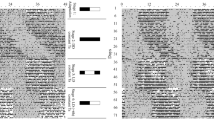Abstract
We undertook a study to determine presence of circadian rhythms during woodchuck hibernation using continuously monitored body temperatures. Males had shorter torpor and longer euthermic periods than females. Circular statistics revealed a significant mean vector for males entering into torpor (10:21 h), but not for females. No significant mean vector was found for male or female arousal from torpor. A contingency test was applied to the torpor bout durations. All 7 males tested had significant τ’s between 24 and 26 h, while 6 of the 13 females tested had significant τ’s with a range of 22–27 h. These results implicate a free-running circadian clock during torpor bouts. Overall, the data support the existence of biological rhythms during hibernation in woodchucks, especially for males during arousals. Since entries into torpor appear to be synchronized for males, arousal periods may be used to resynchronize their circadian system. The persistence of biological rhythms during hibernation may help to insure successful mating in the spring after emergence.


Similar content being viewed by others
Abbreviations
- h:
-
Hour
- SCN:
-
Suprachiasmatic nuclei
- τ:
-
Tau
- T b :
-
Body temperature
References
Batschelet E (1981) Circular statistics in biology. Academic Press, London
Canguilhem B, Malan A, Masson-Pevet M, Nobelis P, Kirsch R, Pevet P, Le Minor J (1994) Search for rhythmicity during hibernation in European hamsters. J Comp Physiol B 163:690–698
Christian JJ, Steinberger E, McKinney TD (1972) Annual cycle of spermatogenesis and testis morphology in woodchucks. J Mammal 53(4):708–716
Concannon PW, Baldwin B, Roberts P, Tennant B (1990) Endocrine correlates of hibernation-independent gonadal recrudescence and limited late-winter breeding season in woodchucks, Marmota monax. J Exp Zoo Suppl 4:203–206
Florant GL, Hill V, Ogilvie MD (2000) Circadian rhythms of body temperature in laboratory and field marmots (Marmota flaviventris). In: Heldmaier G, Klingenspor M (eds) Life in the cold. Springer, Berlin, pp 223–231
Garidou ML, Vivien-Roels B, Pevet P, Miguez J, Simonneaux V (2002) Mechanisms regulating the marked seasonal variation in melatonin synthesis in European hamster pineal gland. Am J Physiol 284:R1043–R1052
Geiser F, Holloway JC, Kortner G, Maddocks TA, Turnbill C, Brigham RM (2000) Do patterns of torpor differ between free-ranging and captive mammals and birds? In: Heldmaier G, Klingenspor M (eds) Life in the cold. Springer, Berlin, pp 95–102
Grahn DA, Miller JD, Houng VS, Heller HC (1994) Persistence of circadian rhythmicity in hibernating ground squirrels. Am J Physiol 266:R1251–R1258
Hastings MH, Follett B (2001) Toward a molecular biological calendar. J Biol Rhythms 16(4):424–430
Heller HC, Ruby NF (2004) Sleep and circadian rhythms in mammalian torpor. Annu Rev Physiol 66:275–289
Humphries MM, Thomas DW, Kramer DL (2003) The role of energy availability in mammalian hibernation: a cost-benefit approach. Physiol Biochem Zoo 76(2):165–179
Hut RA, Barns BM, Daan S (2002) Body temperature patterns before, during, and after semi-natural hibernation in the European ground squirrel. J Comp Physiol B 172:47–58
Kortner G, Geiser F (2000) The temporal organization of daily torpor and hibernation: circadian and circannual rhythms. Chronobiol Int 17:103–128
Kortner G, Song X, Geiser F (1998) Rhythmicity of torpor in marsupial hibernator, the mountain pygmy-possum (Burramys parvus), under natural and laboratory conditions. J Comp Physiol B 168:631–638
Larkin JE, Franken P, Heller HC (2002) Loss of circadian organization of sleep and wakefulness during hibernation. Am J Physiol Regul Integr Comp Physiol 282:R1086–R1095
McNab BK (2002) The physiological ecology of vertebrates. Cornell University Press, Ithaca
Pohl H (1996) Circadian and circannual rhythmicity of hibernation in the Turkish hamster, Mesocricetus brandti. In: Geiser F, Hulbert AJ, Nicol SC (eds) Adaptations to cold. Tenth International Hibernation Symposium. University of New England Press, Armidale, pp 87–93
Revel FG, Herwig A, Garidou ML, Dardente H, Menet JS, Masson-Pevet M, Simonneaux V, Saboureau M, Pevet P (2007) The circadian clock stops ticking during deep hibernation in the European hamster. Proc Natl Acad Sci 104:13816–13820
Ruby NF (2003) Hibernation: when good clocks go cold. J Biol Rhythms 18(4):275–286
Ruby NF, Dark J, Heller HC, Zucker I (1996) Ablation of suprachiasmatic nucleus alters timing of hibernation in ground squirrels. Proc Natl Acad Sci 93:9864–9868
Ruby NF, Burns DE, Heller HC (1999) Circadian rhythms in suprachiasmatic nucleus are temperature-compensated and phase-shifted be heat pulse in vitro. J Neurosci 19(19):8630–8636
Schwarts WJ, de la Iglesia H, Zlomanczuk P, Illnerova H (2001) Encoding Le Quattro Stagioni within the mammalian brain: photoperiodic orchestration through the suprachiasmatic nucleus. J Biol Rhythms 16:302–311
Snyder RL, Christian JJ (1960) Reproductive cycle and litter size of woodchucks. Ecology 41(4):647–656
Strumwasser F, Schlechte FR, Streeter J (1967) The internal rhythms of hibernation. In: Fisher KC, Dawe AD, Lyman CP, Schonbaum E, South FE (eds) Mammalian hibernation III. Oliver and Boyd, Edinburgh, pp 110–139
Sumova A, Travnickova Z, Peters R, Schwartz WJ, Illnerova H (1995) The rat suprachiasmatic nucleus is a clock for all seasons. Proc Natl Acad Sci 92:7754–7758
Wallnik F, Schmidt B (1995) Seasonal and daily rhythms of body temperature in European hamster (Cricetus cricetus) under semis-natural conditions. J Comp Physiol B 165:171–182
Waβmer T, Wollnik F (1997) Timing of torpor bouts during hibernation in European hamsters (Cricetus cricetus L). J Comp Physiol B 167:270–279
Zervanos SM (2003) Timing of hibernation immergence and emergence in woodchucks (Marmota monax). In: Ramousse R, Allaine D, LeBerre M (eds) Adaptive strategies and diversity in marmots. Proceedings of the 4th international conference on the genus Marmota, Montreux, Switzerland. International Network on Marmots (http://www.cons-dev.org/marm/MARM/EMARM/framarm/framarm.html), pp 157–164
Zervanos SM, Salsbury CM (2001) Telemetry system for the continuous monitoring of temperature, location and activity of free-ranging animals. Bull Ecol Soc Am 82(3):189–191
Zervanos SM, Salsbury CM (2003) Seasonal body temperature fluctuations and energetic strategies in free-ranging eastern woodchucks (Marmota monax). J Mammal 84(1):299–310
Author information
Authors and Affiliations
Corresponding author
Additional information
Communicated by H. V. Carey.
Rights and permissions
About this article
Cite this article
Zervanos, S.M., Salsbury, C.M. & Brown, J.K. Maintenance of biological rhythms during hibernation in Eastern woodchucks (Marmota monax). J Comp Physiol B 179, 411–418 (2009). https://doi.org/10.1007/s00360-008-0327-z
Received:
Revised:
Accepted:
Published:
Issue Date:
DOI: https://doi.org/10.1007/s00360-008-0327-z




